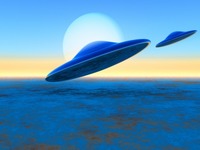
Earth's Meteor Impact Map
A giant rock, perhaps half a mile in diameter, may be hurtling towards us this very minute through the emptiness of space. If it strikes the Earth, or blows up in the atmosphere, the explosion would be equivalent to that of 100 million tons of TNT, twice as powerful as the largest nuclear bomb ever detonated. If it struck the United States, it could wipe out a small state. But chances are, we will never see it coming. Source - Planetary News
While the world focuses its attention on the hotly debated "effects" of Global Warming, scientists and one lone politician want the United States to wakeup and help fund what they claim is a very real threat.
Rep. Dana Rohrabacher (R) of California fears the United States isn't prepared to prevent an asteriod striking a large metropolitan area which would lead to "millions of people dead". Rohrabacher wants the U.S. to have a plan where asteroids can be detected, then deflected or destroyed, before they have chance to hit the United States.
No one knows what exactly what caused the 770 square mile area of Tunguska, Siberia to be destroyed on June 30, 1908, but scientists surmise it was a good sized asteroid that exploded in Earth's atmosphere before impact.
According to the National Geographic News, the explosion that leveled the unpopulated area was equivalent to 200 Hiroshima-size atomic bombs. Scientists believe the area was struck by an asteroid not much wider than a football field.
Prevention would be a matter of detection, and Rohrabacher wants the U.S. to implement some sort of asteriod early warning system. NASA has indentified 959 asteroids as being "potentially dangerous". Asteroids making the "Most Wanted" list must be at least 150 meters wide and "capable of approaching Earth within 4.7 million miles.

The Meteor Crater in Arizona was up until recently considered a mystery to scientists. According to Robert Roy Britt of Space.com the mystery surrounding the crater was the amount of melted rock, the crater had less than what was expected.
A computer model, dubbed the Catastrophe Calculator, shows the estimated 300,000 ton, 130 ft. in diameter asteroid breaking up, then slamming into the Arizonian desert landscape, at 26,800 miles per hour. The resulting impact: a huge gaping hole, 570 ft. deep by 4100 ft. wide.
Scientists now believe the asteroid "slowed" considerably when it hit the Earth's atmosphere. It was previous calculations, that the asteroid was traveling at a higher rate of speed, 34,000 mph, that led scientists to believe there should have been more melted rock left behind after the massive impact.
Read more of Scientists Claim Massive Asteroid Strike Preventable at DBKP.com
Source - Planetary.org - Funding woes halt plans for search
Source - National Geographic
Source - Space.com - Mystery of Arizona's Meteor Crater Solved
Image - Arizona Meteor Crater
Image - Earth Meteor Impact Map
Death by 1000 Papercuts Front Page.






























No comments:
Post a Comment
Leave your name/nic.
We've changed the comments section to allow non-registered users to comment.
We'll continue like that until it's being abused.
We reserve the right to delete all abusive or otherwise inappropriate comments.